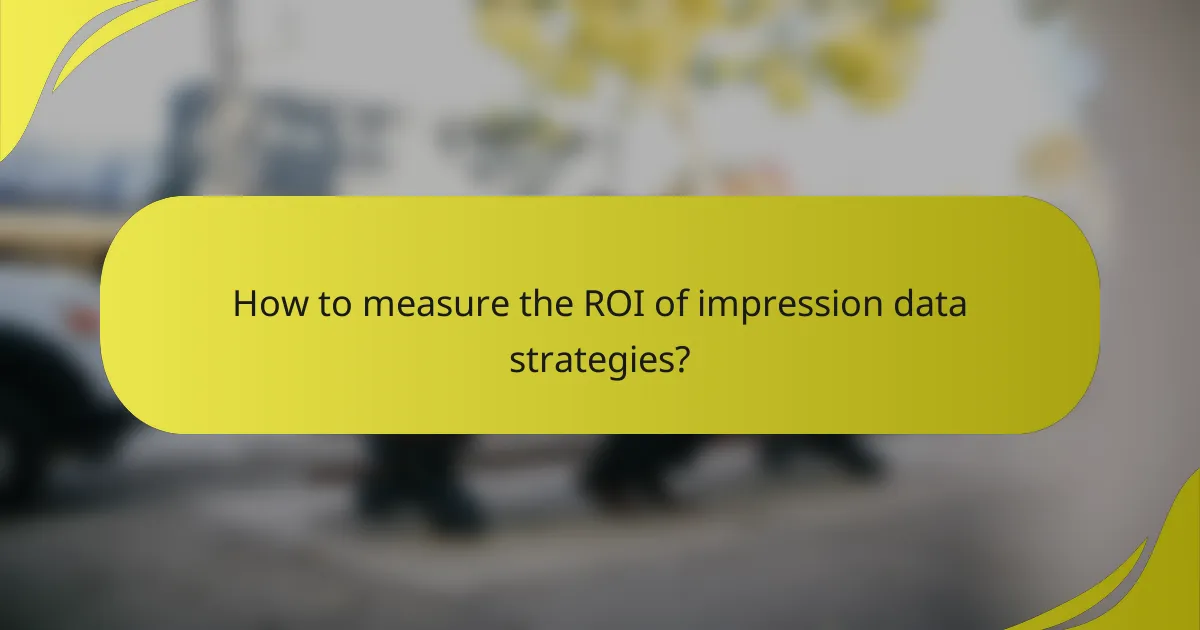Impression data analysis is crucial for optimizing display advertising by revealing how frequently ads are viewed and assessing the effectiveness of their placements. By understanding user behavior and leveraging insights from this data, advertisers can refine their targeting strategies, enhance audience engagement, and ultimately improve campaign performance and return on investment.

How to analyze impression data for display advertising?
Analyzing impression data for display advertising involves examining how often ads are viewed and understanding the effectiveness of ad placements. This process helps advertisers optimize their campaigns to reach the right audience and improve overall performance.
Utilize analytics tools like Google Analytics
Google Analytics is a powerful tool for analyzing impression data. By integrating your display advertising campaigns with Google Analytics, you can track impressions, clicks, and conversions in one place. This allows you to see which ads are performing well and which need adjustments.
To get started, set up goals in Google Analytics that align with your advertising objectives. Monitor the performance of different ads and placements to identify trends and make data-driven decisions. Regularly reviewing this data can lead to improved ROI on your advertising spend.
Segment data by audience demographics
Segmenting impression data by audience demographics is crucial for targeted advertising. By analyzing who is viewing your ads—based on age, gender, location, and interests—you can tailor your campaigns to better resonate with specific groups. This targeted approach often results in higher engagement rates.
Use tools like Google Analytics or social media insights to gather demographic information. Create segments based on this data and test different ad creatives or messages for each group. This can help you identify which demographics respond best to your ads, allowing for more effective targeting.
Measure engagement metrics
Engagement metrics are essential for understanding how users interact with your ads. Key metrics include click-through rates (CTR), conversion rates, and time spent on site after clicking an ad. These indicators provide insights into the effectiveness of your display advertising.
To measure engagement, regularly analyze these metrics and compare them against industry benchmarks. A low CTR may indicate that your ad creative needs improvement, while a high conversion rate suggests that your landing page is effective. Adjust your strategies based on these insights to enhance overall campaign performance.

What are effective targeting strategies using impression data?
Effective targeting strategies using impression data focus on understanding user behavior, content context, and geographic location to optimize ad placements. By leveraging these insights, marketers can enhance engagement and conversion rates while minimizing wasted impressions.
Behavioral targeting based on user activity
Behavioral targeting utilizes data on user activity to tailor advertisements to individual preferences. This strategy analyzes past interactions, such as website visits, clicks, and purchases, to predict future behavior and deliver relevant ads. For example, if a user frequently browses sports equipment, they may receive targeted ads for athletic gear.
When implementing behavioral targeting, consider segmenting your audience into distinct groups based on their actions. This allows for more personalized messaging and can significantly improve engagement rates. However, be cautious of privacy regulations, such as GDPR, which require transparency in data usage.
Contextual targeting aligned with content
Contextual targeting involves displaying ads based on the content of the webpage where the impression occurs. This strategy ensures that ads are relevant to what users are currently reading or viewing, increasing the likelihood of engagement. For instance, an article about cooking may feature ads for kitchen appliances or recipe books.
To effectively utilize contextual targeting, analyze the keywords and themes of your content. Tools that assess page context can help match advertisements to relevant topics. Keep in mind that while this method is effective, it may not account for individual user preferences, so combining it with behavioral data can enhance results.
Geotargeting for local campaigns
Geotargeting focuses on delivering ads to users based on their geographic location, making it ideal for local campaigns. This strategy allows businesses to reach potential customers in specific areas, such as promoting a local restaurant to users within a certain radius. For example, a coffee shop might target ads to users within a few kilometers to drive foot traffic.
When implementing geotargeting, consider using location data from mobile devices or IP addresses to refine your audience. Ensure that your messaging resonates with local culture and preferences, and be aware of any regional regulations regarding data privacy. This approach can lead to higher conversion rates, especially for businesses reliant on local clientele.

What insights can be derived from impression data?
Impression data provides valuable insights into ad performance, audience engagement, and overall marketing effectiveness. By analyzing this data, businesses can make informed decisions to enhance their advertising strategies and improve return on investment.
Identify high-performing ad placements
High-performing ad placements can be identified by analyzing impression data to see where ads receive the most visibility and engagement. Look for placements that consistently generate higher click-through rates (CTR) and conversions compared to others.
Consider using A/B testing to compare different placements. For instance, if an ad on a specific website or social media platform shows a significantly higher CTR, prioritize that placement in future campaigns.
Understand audience preferences and trends
Impression data helps in understanding audience preferences by revealing which ads resonate most with specific demographics. By segmenting data based on age, gender, or location, marketers can tailor their campaigns to better meet audience needs.
Track trends over time to see how audience behavior changes. For example, if younger audiences are increasingly engaging with video ads, consider allocating more budget to video content to capitalize on this trend.
Optimize ad creatives based on performance
Optimizing ad creatives involves analyzing which elements drive the most impressions and engagement. Look for patterns in successful ads, such as specific images, headlines, or calls to action that lead to higher performance.
Regularly update and test ad creatives based on performance data. If certain visuals or messages are underperforming, replace them with new concepts to keep the audience engaged and improve overall effectiveness.

What are the prerequisites for effective impression data analysis?
Effective impression data analysis requires a clear understanding of campaign objectives, proper implementation of tracking mechanisms, and adherence to data privacy regulations. These elements ensure that the data collected is relevant, accurate, and compliant with legal standards.
Set clear campaign objectives
Establishing clear campaign objectives is crucial for effective impression data analysis. Objectives should be specific, measurable, achievable, relevant, and time-bound (SMART). For example, a campaign might aim to increase brand awareness by 20% within three months, guiding the analysis toward relevant metrics.
When setting objectives, consider the target audience and desired outcomes. This clarity helps in selecting the right metrics to track and ensures that the analysis focuses on what truly matters for the campaign’s success.
Implement tracking pixels correctly
Correctly implementing tracking pixels is essential for gathering accurate impression data. Tracking pixels should be placed on key pages and events, such as landing pages and conversion points, to capture user interactions effectively. Ensure that the pixel code is functioning properly and firing at the right times.
Regularly test the tracking setup to identify any issues that may lead to data loss or inaccuracies. Using tools like Google Tag Manager can simplify this process and help manage multiple pixels efficiently.
Ensure data privacy compliance
Data privacy compliance is a fundamental requirement for impression data analysis. Familiarize yourself with regulations such as the General Data Protection Regulation (GDPR) in Europe or the California Consumer Privacy Act (CCPA) in the U.S. These laws dictate how personal data should be collected, stored, and used.
Implement clear consent mechanisms to inform users about data collection practices. This can include cookie banners or opt-in forms. Regular audits of your data practices can help ensure ongoing compliance and build trust with your audience.

How to measure the ROI of impression data strategies?
Measuring the ROI of impression data strategies involves assessing the financial returns generated from advertising impressions relative to their costs. This process helps determine the effectiveness of marketing efforts and guides future investment decisions.
Calculate cost per impression (CPI)
Cost per impression (CPI) is a critical metric that indicates how much you spend for each impression your advertisement receives. To calculate CPI, divide the total cost of your advertising campaign by the number of impressions generated. For example, if you spend $1,000 and receive 100,000 impressions, your CPI would be $0.01.
Monitoring CPI helps identify whether your advertising spend is efficient. A lower CPI suggests better cost efficiency, while a higher CPI may indicate the need for strategy adjustments. Aim for a CPI that aligns with your overall marketing budget and objectives.
Analyze conversion rates from impressions
Conversion rates measure the percentage of users who take a desired action after viewing your ad. To analyze this, divide the number of conversions by the total impressions and multiply by 100. For instance, if you have 500 conversions from 100,000 impressions, your conversion rate is 0.5%.
Understanding conversion rates allows you to evaluate the effectiveness of your impression data strategies. A low conversion rate may signal that your targeting or messaging needs refinement. Regularly track and compare these rates to optimize your campaigns.
Compare against industry benchmarks
Comparing your ROI metrics against industry benchmarks provides context for your performance. Research typical CPI and conversion rates within your sector to gauge how well your strategies are performing. For example, if the average CPI in your industry is $0.05 and yours is $0.01, you are performing exceptionally well.
Utilizing industry benchmarks helps identify areas for improvement and can inform your advertising strategy. Keep in mind that benchmarks can vary widely by industry, so ensure you are referencing relevant data for accurate comparisons.

What tools are available for impression data analysis?
Several tools are available for analyzing impression data, each offering unique features tailored to different advertising platforms. These tools help marketers track performance, optimize campaigns, and derive actionable insights from their data.
Google Ads for ad performance tracking
Google Ads provides robust tools for tracking ad impressions and performance metrics. Users can access detailed reports that show how ads are performing across various networks, including search and display.
Key metrics include impressions, click-through rates, and conversion rates. Marketers should regularly review these metrics to identify trends and adjust their bidding strategies accordingly.
To maximize effectiveness, set clear goals for each campaign and use A/B testing to determine which ad variations yield the best results. Avoid common pitfalls like neglecting to monitor keyword performance or failing to adjust bids based on impression share.
Facebook Ads Manager for social impressions
Facebook Ads Manager is essential for analyzing social media impressions and engagement. This tool allows advertisers to track how their ads perform across Facebook and Instagram, providing insights into audience behavior and preferences.
Key features include audience insights, ad performance metrics, and the ability to create custom reports. Advertisers should focus on metrics such as reach, engagement rates, and cost per thousand impressions (CPM) to gauge effectiveness.
To enhance targeting, utilize Facebook’s audience segmentation tools and retargeting options. Avoid overspending by setting daily or lifetime budgets and regularly reviewing ad performance to make necessary adjustments.

